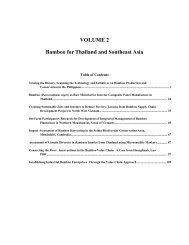WBC-VIII-Vol.4 – Resources – Forestry, Plantations and ... - BambuSC
WBC-VIII-Vol.4 – Resources – Forestry, Plantations and ... - BambuSC
WBC-VIII-Vol.4 – Resources – Forestry, Plantations and ... - BambuSC
You also want an ePaper? Increase the reach of your titles
YUMPU automatically turns print PDFs into web optimized ePapers that Google loves.
In the other h<strong>and</strong>, guadua bamboo forests also accomplish important functions contributing to the mitigation of<br />
climate change, soil protection <strong>and</strong> water regulation. Because of population dynamics <strong>and</strong> biomass of guadua,<br />
these forests have a high worth as carbon sink (Riaño et al. 2002). Moreover, the guadua has been often used by<br />
government institutions for reforestation programs <strong>and</strong> important changes can be observed concerning to<br />
improvement of soils conditions under reforested areas. For theses reasons, the enhancements of environmental<br />
services or ecosystems functions have been attributed to this bamboo species (Cruz 1994, Giraldo <strong>and</strong> Sabogal<br />
1999).<br />
In order to promote the proper utilisation <strong>and</strong> management of guadua <strong>and</strong> the productivity options available to<br />
farmers in the Colombian coffee region, information on growth <strong>and</strong> productivity as well as the bases of<br />
silvicultural management are analised in this work . In addition an application of a simple model to integrate<br />
spatial information <strong>and</strong> attributes of l<strong>and</strong> <strong>and</strong> guadua st<strong>and</strong>s is applied as strategy for planning of guadua forest.<br />
Also to elucidate the true meaning of environmental services <strong>and</strong> ecosystems functions offered by guadua<br />
bamboo forest, quantitative information on variables associated to environmental services <strong>and</strong> ecosystems<br />
functions as carbon sequestration <strong>and</strong> soil protection provided by guadua bamboo forest is presented here.<br />
Silvicultural management<br />
In Colombia <strong>and</strong> specifically in the coffee region, most of the silvicultural practices have been developed <strong>and</strong><br />
applied to natural guadua st<strong>and</strong>s. This statement has its main justification because there is considerably more<br />
area under natural guadua st<strong>and</strong>s than guadua plantations. According to the most recent guadua inventory in the<br />
coffee region there is an estimates of 28,000 ha (Morales <strong>and</strong> Kleinn 2006). In contrast, have been registered no<br />
more than 4000 ha of guadua plantations (CARDER 2000) of which there are not yet official registers of<br />
harvests. In addition, practices related to establishing <strong>and</strong> the dynamics of clumps during the first stage of<br />
development are only focused when guadua plantations area managemed. In order to describe silvicultural<br />
practices applied to guadua in Colombia, natural guadua st<strong>and</strong>s <strong>and</strong> guadua plantations should be separately<br />
analysed.<br />
Bases of silvicultural management are supported on information on growth, productivity <strong>and</strong> quality.<br />
Consequently, before to describe silvicultural practices <strong>and</strong> their effect, it would be essential to emphasised on<br />
guadua inventory <strong>and</strong> mensuration.<br />
Guadua inventory <strong>and</strong> mensuration<br />
Growth pattern of tree <strong>and</strong> bamboos are wholly different. Hence, bamboo growth <strong>and</strong> productivity should be<br />
measured taking into consideration the best manner to obtain consistent information on dendrometric <strong>and</strong> st<strong>and</strong><br />
variables. As in other bamboos, guadua culms are curved in the upper section. It means that the measured height<br />
does not correlate with culm growth. For trees, height <strong>and</strong> length are usually almost identical. In contrast, for<br />
this bamboo species culm length <strong>and</strong> culm height are considerably different. Therefore, the variable of interest is<br />
obviously culm length because it is directly related to the commercial product (Figure 1).<br />
<strong>VIII</strong> World Bamboo Congress Proceedings Vol 4-36




